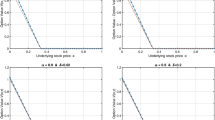Abstract
We introduce the mathematical modeling of American put option under the fractional Black–Scholes model, which leads to a free boundary problem. Then the free boundary (optimal exercise boundary) that is unknown, is found by the quasi-stationary method that cause American put option problem to be solvable. In continuation we use a finite difference method for derivatives with respect to stock price, Grünwal Letnikov approximation for derivatives with respect to time and reach a fractional finite difference problem. We show that the set up fractional finite difference problem is stable and convergent. We also show that the numerical results satisfy the physical conditions of American put option pricing under the FBS model.

Similar content being viewed by others
References
Amin, k, & Khanna, A. (1994). Convergence of American option values from discrete to continuous-time financial models. Mathematical Finance, 4, 289–304.
Baleanu, D., Diethelm, K., Scalar, E., & Trujillo, J. J. (2012). Fractionak caculus, model and numerical methods (Vol. 3). Singapore: World Scientific.
Barraquand, J., & Pudet, T. (1994). Pricing of American path-dependent contingent claims. Paris: Digital Research Laboratory.
Black, F., & Scholes, M. S. (1973). The pricing of options and corporate liabilities. Journal of Political Economy, 81, 637654.
Broadie, M., & Detemple, J. (1996). American option valuation: New bounds, approximations, and a comparison of existing methods. Review of Financial Studies, 9(4), 121–150.
Hull, J. C. (1997). Options futures and other derivatives. Upper Saddle River: Prentice Hall.
Jumarie, G. (2008). Stock exchange fractional dynamics defined as fractional exponential growth driven by (usual) Gaussian white noise application to fractional Black–Scholes equations. Insurance Mathematics and Economics, 42, 271–287.
Kalanatri, R., & Shahmorad, S., & Ahmadian, D. , (2015). The stability analysis of predictor-corrector method in solving American option pricing model. Computer Econonics. doi:10.1007/s10614-015-9483-x.
Kwok, Y. K. (1998). Mathematical models of financial derivatives. Heidelberg: Springer.
Kwok, Y. K. (2009). Mathematical models of financial derivatives (Vol. 2). Berlin: Springer.
Meng, Wu, Nanjing, H., & Huiqiang, M. (2014). American option pricing with time-varying parameters. Computer Economics, 241, 439–450.
Merton, R. C. (1973). The theory of rational option pricing. The Bell Journal of Economics and Management of Science, 4, 141–183.
Podlubny, I. (1999). Fractional differential equations. Cambridge: Academic press.
Ross, S. H. (1999). An Introduction to mathematical finance. Cambridge: Cambridge University Press.
San-Lin, C. (2000). American option valuation under stochastic interest rates. Computer Economics, 3, 283–307.
Smith, G. D. (1985). Numerical solution of partial differential equations: Finite difference methods. Oxford: Clarendon Press.
Wilmott, P. (1998). The theory and practice of financial engineering. New York: Wiley.
Wilmott, P., Dewynne, J., & Howison, S. (1993). Option pricing, mathematical models and computation. Oxford: Oxford Financial Press.
Yu, D., & Tan, H. (2003). Numerical methods of differential equations. Beijing: Science Publisher.
Zhuang, P., Liu, F., Anh, V., & Turner, I. (2009). Numerical methods for the variable-order fractional advection–diffusion equation with a nonlinear source term. SIAM Jouranl of Numerical Analysis, 47, 1760–1781.
Author information
Authors and Affiliations
Corresponding author
Rights and permissions
About this article
Cite this article
Kalantari, R., Shahmorad, S. A Stable and Convergent Finite Difference Method for Fractional Black–Scholes Model of American Put Option Pricing. Comput Econ 53, 191–205 (2019). https://doi.org/10.1007/s10614-017-9734-0
Accepted:
Published:
Issue Date:
DOI: https://doi.org/10.1007/s10614-017-9734-0




